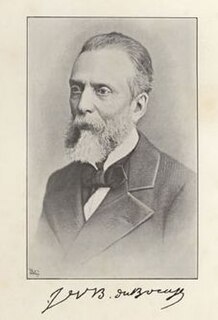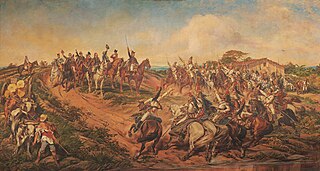Related Research Articles

Angra dos Reis is a Brazilian municipality located in the southern part of Rio de Janeiro state. Angra is located by the sea and includes in its territory many offshore islands, the largest being Ilha Grande.

The National Museum of Brazil is the oldest scientific institution of Brazil. It is located in the city of Rio de Janeiro, where it is installed in the Paço de São Cristóvão, which is inside the Quinta da Boa Vista. The main building was originally the residence of the Portuguese royal family between 1808 and 1821 and was later used to house the Brazilian imperial family between 1822 and 1889. After the monarchy was deposed, it hosted the Republican Constituent Assembly from 1889 to 1891 before being assigned to the use of the museum in 1892. The building was listed as Brazilian National Heritage in 1938 and was largely destroyed by a fire in 2018.

José Vicente Barbosa du Bocage was a Portuguese zoologist and politician. He was the curator of Zoology at the Museu Nacional de Lisboa in Lisbon. He published numerous works on mammals, birds, and fishes. In the 1880s he became the Minister of the Navy and later the Minister for Foreign Affairs for Portugal. The zoology collection at the Lisbon Museum is called the Bocage Museum in his honor.

The National Museum of Archaeology is the largest archaeological museum in Portugal and one of the most important museums devoted to ancient art found in the Iberian Peninsula. Located in Lisbon, the museum was founded in 1893 by the archaeologist José Leite de Vasconcelos. The museum is located in the western wing of the Jeronimos Monastery where the monks had their dormitory. The museum is built in the Neo-Manueline style and was officially opened in 1906.

Luzia Woman is the name for an Upper Paleolithic period skeleton of a Paleo-Indian woman who was found in a cave in Brazil. Some archaeologists originally thought the young woman may have been part of a migratory wave of immigrants prior to the ancestors of today's Amerindians, though DNA and other evidence has shown this to be improbable. The 11,500-year-old skeleton was found in a cave in the Lapa Vermelha archeological site in Pedro Leopoldo, in the Greater Belo Horizonte region of Brazil, in 1974 by archaeologist Annette Laming-Emperaire. The nickname Luzia was chosen in homage to the Australopithecus fossil Lucy. The fossil was kept at the National Museum of Brazil, where it was shown to the public until it was fragmented during a fire that destroyed the museum on September 2, 2018. On October 19, 2018, it was announced that most of Luzia's remains were identified from the Museu Nacional debris, which allowed them to rebuild part of her skeleton.

Angrites are a rare group of achondrites consisting mostly of Al-Ti bearing diopside, hedenbergite, olivine, anorthite and troilite with minor traces of phosphate and metals. The group is named for the Angra dos Reis meteorite. They are the oldest igneous rocks, with crystallization ages of around 4.56 billion years. Angrites are subdivided into two main groups, the quenched and plutonic angrites. The quenched angrites cooled rapidly upon the surface of the angrite parent body (APB), whereas the plutonic angrites cooled slower, deeper in the crust. The APB is thought to have been a similar size to the asteroid 4 Vesta.

Paço de São Cristóvão was an imperial palace located in the Quinta da Boa Vista park in the Imperial Neighbourhood of São Cristóvão, Rio de Janeiro, Brazil. It served as residence to the Portuguese Royal Family and later to the Brazilian Imperial Family until 1889, when the country became a republic through a coup d'état deposing Emperor Pedro II. The palace briefly served as a public building by the provisional government for the constituent assembly of the first republican constitution. It housed the major part (92.5%) of the collections of the National Museum of Brazil, which, together with the building, were largely destroyed by a fire on 2 September 2018.
The Fort of Má Ferramenta, near the port of the civil parish of São Mateus da Calheta, municipality of Angra do Heroísmo, along the southern coast of the Portuguese island of Terceira, in the archipelago of the Azores. Located in a dominant position over this coastal stretch of coast that sheltered anchored ships, it was a fortification used as a defence against attacks from pirates and corsairs, that frequented the waters of the mid-Atlantic.

José Carlos de Carvalho Júnior was a Brazilian rear admiral and politician in the Empire of Brazil, best known for his service in the Paraguayan War and his role in the expedition carried out to the interior of Bahia in 1887 to recover the Bendegó meteorite from where it had been laying for more than a hundred years since the first attempt to remove it made in 1785 and transport it to the court in Rio de Janeiro.
Augusto Carlos Teixeira de AragãoComA • CavC • CavA • CavTE was a Portuguese officer, doctor, numismatist, archaeologist and historian. As an officer of the Portuguese army, he retired with the rank of general. Teixeira de Aragão is considered one of the "fathers" of Portuguese numismatics.

The Museu da Música is a museum in Lisbon, Portugal. The museum primarily features musical instruments; among its holdings is a 1725 Stradivarius cello once owned and played by King Luís I of Portugal (ruled 1861–1889.

The 1888 painting Independence or Death, also known as the Cry of Ipiranga, is the main artwork representing the proclamation of the Brazilian independence.

The Bendegó Meteorite is a meteorite found in the interior of the state of Bahia, Brazil. It is the biggest iron meteorite ever found in Brazilian soil, weighting 5,360 kilograms (11,820 lb). It has been on display at the National Museum of Brazil, in Rio de Janeiro, since 1888.
Luiz Otávio Anacleto Leandro, known as Luiz Otávio, is a Brazilian footballer who plays for Ceará as a central defender.

The National Museum of Brazil was heavily damaged by a large fire which began about 19:30 local time on 2 September 2018. Although some items were saved, it is believed that 92.5% of its archive of 20 million items were destroyed in the fire as around 1.5 million items were stored in a separate building, which were not damaged.

The National Museum of Brazil collections include an exhibition of meteorites discovered in Brazil and other countries.

Meteorito de Bendegó – relatório apresentado ao ministerio da agricultura, commercio e obras publicas e a sociedade de geographia do Rio de Janeiro sobre a remoção do meteorito de Bendengó do sertão da provincia da Bahia para o Museu Nacional is a book written by José Carlos de Carvalho and published in 1888 in Portuguese and French. It deals with the transportation of the Bendegó meteorite from Bahia to the National Museum, under the command of the Emperor Dom Pedro II.
Miss Brazil CNB 2018 was the 29th edition of the Miss Brazil CNB pageant and the 4th under CNB Miss Brazil. The contest took place on August 11, 2018. Each state, the Federal District and various Insular Regions & Cities competed for the title. Gabrielle Vilela of Rio de Janeiro crowned her successor, Jéssica Carvalho of Piauí at the end of the contest. Carvalho represented Brazil at Miss World 2018. The contest was held at the Hotel do Bosque in Angra dos Reis, Rio de Janeiro, Brazil.
Miss Brazil CNB 2017 was the 28th edition of the Miss Brazil CNB pageant and the 3rd under CNB Miss Brazil. The contest took place on August 12, 2017. Each state, the Federal District and various Insular Regions & Cities competed for the title. Beatrice Fontoura of Goiás crowned her successor, Gabrielle Vilela of Rio de Janeiro at the end of the contest. Vilela represented Brazil at Miss World 2017. The contest was held at the Hotel do Bosque in Angra dos Reis, Rio de Janeiro, Brazil.

António Manuel Filipe Rocha Pimentel is a Portuguese academic and art historian currently the director of the Calouste Gulbenkian Museum in Lisbon, Portugal.
References
- ↑ "Angra dos Reis". Meteoritical Society. Retrieved 3 January 2013.
- ↑ "Angra dos Reis". Meteoritestudies. Retrieved 3 January 2013.
- ↑ "Meteorito de R$ 3 milhões segue perdido nos escombros do Museu Nacional" (in Portuguese). 25 September 2018.
- ↑ "O meteorito que vale R$ 3 milhões e está perdido nos escombros do Museu Nacional" (in Portuguese). 25 September 2018.
- ↑ "Meteorito que vale milhões de reais é recuperado dos escombros do Museu Nacional" (in Portuguese). 25 September 2018.
- ↑ "The Angrite Meteorite Mystery" (PDF). NASA. Archived from the original (PDF) on 2012-09-17. Retrieved 2013-01-03.